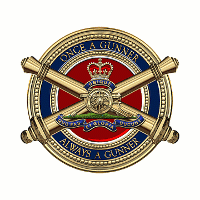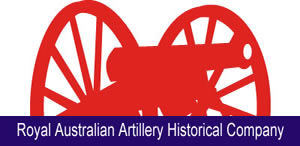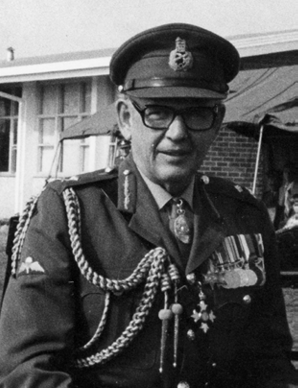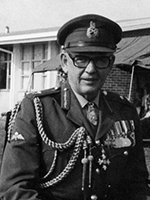The Japanese thrust in the Pacific ended any chance of John’s going to the Middle East and he was at Headquarters 2nd Division in Western Australia when posted to New Guinea. After a painfully long train trip from Geraldton, WA to Townsville in North Queensland, Captain John Whitelaw joined the last elements of 4th Field Regiment (Jungle Division) AIF as they sailed for Lae, New Guinea. He moved forward to Dumpu in the Ramu Valley and became the battery captain of 12th Battery. Amongst the guns his battery took over from the 2/4th Field Regiment AIF were the two 25-Pounder Shorts that had been parachuted into Nadzab at the beginning of this campaign in September 1943. He recalled the extreme physical effort required to move single guns and ammunition forward across the towering Finisterre Ranges — ‘50 men took three days to deliver 50 rounds of ammunition to the left flank gun’.
In June 1944, John succumbed to dengue fever and hepatitis, was hospitalised and returned to Australia for recuperation leave. On return to his unit then near Lae, he became the commander of E Troop and endued the divisional artillery undergoing ‘School of Artillery type’ training.
Relief came when Captain Whitelaw’s unit was deployed as part of the 2nd Australian Corps to Bougainville on 1st November 1944 where he observed that Torokina living conditions left by the Americans were luxury.
John’s 11th Battery was deployed up the Numa Numa Trail in support of the 31st/51st Battalion. As a forward observation officer, he was continually involved trudging on patrol support with the occasional ‘little bit of a job on a Japanese position’ to improve his morale.
On 6th June 1944, an amphibious assault onto Porton Plantation by the 31st/51st Battalion was planned to cut off the withdrawing Japanese. This developed into a disaster and Captain Whitelaw was tasked to navigate the final group of armoured barges with assault boats to collect the survivors. He earned a mention in despatches for his accurate navigation and laying a very effective smoke screen along the beach to cloud the clear moonlight and facilitate a successful withdrawal.
News of peace was received on 11th August and in October Captain Whitelaw was transferred to the 2/14th Field Regiment in Rabaul. There he was posted to the Army Movement Control Staff which began returning soldiers to Australia and in September 1946, it was his turn to go home. Captain John Whitelaw was transferred to the Reserve of Officers and returned to his old job back with Spicers in Melbourne. When asked what was the greatest benefit he derived from six years of war service, he replied, ‘Without it you don’t know what ... [soldiering] is all about ... the noise of an angry shot ... focuses your mind!’
John married Nancy Bogle (the sister of fellow Gunner officer Bruce Bogle) in December 1947. The following year, Spicers transferred him to their Perth, WA office.
When the Citizen Military Force (CMF) was restructured, Captain Whitelaw returned to the Active List with Headquarters Western Command on 4th July 1948. After six years’ full-time war service and with a father and brother in the permanent Army, John’s ambitions led him to apply for a commission in the Interim Army. His appointment on 1st July 1949 began a full-time army career which consumed him for the next 29 years during which he rose to become a major general and Deputy Chief of the General Staff.
To discuss the 26 postings John held throughout a most successful military career would take more time than can reasonably be allowed for this tribute. However, the following have been selected to highlight the remarkable career of Major General John Whitelaw.
His first substantial posting back to the Gunners was as adjutant of 1st Field Regiment at Georges Heights in Sydney under the command of Paddy O’Hare.
During 1955, now Major Whitelaw, Nancy and their three daughters enjoyed the delights of the Canadian Staff College at Kingston. The Canadians liked John so much, he was appointed the exchange instructor for the next two years.
His Grade One staff appointments included Headquarters Western then Northern Commands and Headquarters 1st (Pentropic) Division, Sydney in 1963. Then came another accompanied overseas posting to Singapore as the Assistant Adjutant and Quarter Master General at Headquarters Australian Army Force, Far East Land Force in 1966. This posting with the British Raj continued as he then stepped up to the Deputy Commander’s appointment.
The penance for Singapore was returning to Army Office in Canberra in 1968 as the Director Equipment Policy: the salve was being promoted colonel.
In April 1970, Colonel Whitelaw was appointed the Chief of Staff at Headquarters Australian Army Forces Vietnam. For his sterling work in this appointment, John was appointed a Commander of the Order of the British Empire (CBE) and awarded the United States Bronze Star.
Back at Army Headquarters in March 1971, John was appointed Director Military Operations and Plans and promoted brigadier. He then became the Chief of Operations and rose to major general. The Chief of Personnel’s door opened to John Whitelaw in 1975 and the Queen’s Birthday Honours List in 1977 appointed him an Officer of the Order of Australia (AO) for his distinguished service in this position.
John reached the pinnacle of his army career in 1977 when he was appointed the Deputy Chief of the General Staff. Major General John Whitelaw, AO, CBE was placed on the Retired List of officers on his 57th birthday on 11th June 1978, bringing to a close a total of 41 years of almost continuous service as a soldier.
Retirement from the Army did not mean giving up work and for the next 24 years, John Whitelaw continued to serve - on the Council of the National Heart Foundation, as the founding Executive Director of the National Farmers’ Federation and finally with Greening Australia for which he was given an Award for Outstanding Achievement in December 1996. In parallel with this work, he had been very active in veterans’ welfare matters as national president of the Regular Defence Force Welfare Association and vice-president of the Australian Veterans and Defence Services Council.
Delivering the military eulogy at John’s funeral, Major General Tim Ford, AO (Retd) emphasised that, ‘the golden thread throughout John Whitelaw’s military and civilian careers was his abiding passion for history and heritage. For over 50 years, John Whitelaw displayed an extraordinary interest in the Australian Army, and particularly its artillery heritage and history. As DCGS he established and was the founding chairman of the Army History Committee that created the first Army Staff Instruction on Army Heritage and History.’
John Whitelaw was the driving force behind construction of the RAA National Memorial on Mount Pleasant and its opening by Her Majesty Queen Elizabeth II, our Captain General in 1977, and in the creation of the RAA National Museum at North Fort in Sydney. He was the founding and only patron of the RAA Historical Society which lay the foundations for the outstanding collection and display of artillery equipments and memorabilia now resident at North Fort—the site of the 9.2-inch Coast Artillery Battery over which John had walked frequently when his father was Commander Fixed Defences during the Second World War.
He was the first chairman of the History Sub Committee (HSC) of the RAA Regimental Committee which was formed in 2005. His inspired leadership, dedicated example and continuing as a project team leader on several issues after ill health obliged him to hand over the chair, were inspirational to all other members of the HSC. He impressed the whole Regimental Committee with his dedication and enthusiasm for this task which now has some 20 volunteers undertaking research into 28 artillery related topics.
In addition to these historical services to the Royal Regiment of Australian Artillery, Major General John Whitelaw was the Colonel Commandant of NSW from 1978 to 1984 and Representative Colonel Commandant of the Regiment from 1980 to 1984, a role in which he sagely guided the RAA’s history, customs, traditions and standing in the community.
John Whitelaw not only came from a military family - he became an integral part of the military family of the Gunners of his Regiment, the soldiers of the Australian Army and was a shining example to all members of the Australian Defence Force. John was also a devoted family man. To his wife, Nancy, his three daughters Angela, Belinda and Virginia and their families, he was the loving patriarch of the family.
Vale : Major General John Whitelaw, AO, CBE — officer, gentleman and military historian—a Gunner of distinction. |








